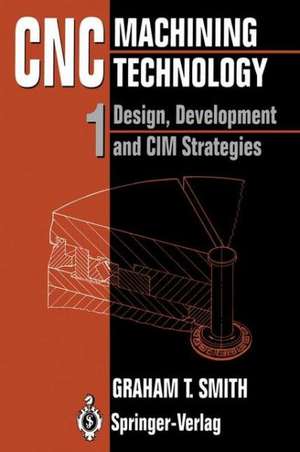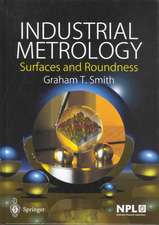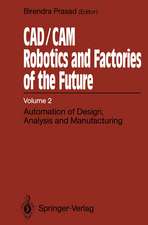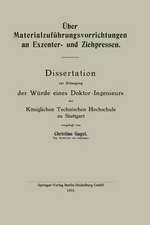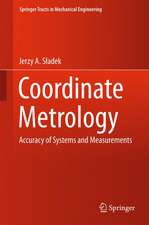CNC Machining Technology: Volume I: Design, Development and CIM Strategies
Autor Graham T. Smithen Limba Engleză Paperback – 30 mar 1993
| Toate formatele și edițiile | Preț | Express |
|---|---|---|
| Paperback (2) | 635.31 lei 43-57 zile | |
| SPRINGER LONDON – 30 mar 1993 | 635.31 lei 43-57 zile | |
| SPRINGER LONDON – 30 mar 1993 | 635.80 lei 43-57 zile |
Preț: 635.31 lei
Preț vechi: 747.43 lei
-15% Nou
Puncte Express: 953
Preț estimativ în valută:
121.60€ • 132.13$ • 102.21£
121.60€ • 132.13$ • 102.21£
Carte tipărită la comandă
Livrare economică 21 aprilie-05 mai
Preluare comenzi: 021 569.72.76
Specificații
ISBN-13: 9783540198284
ISBN-10: 3540198288
Pagini: 192
Ilustrații: X, 178 p. 81 illus.
Dimensiuni: 155 x 235 x 10 mm
Greutate: 0.28 kg
Ediția:1993
Editura: SPRINGER LONDON
Colecția Springer
Locul publicării:London, United Kingdom
ISBN-10: 3540198288
Pagini: 192
Ilustrații: X, 178 p. 81 illus.
Dimensiuni: 155 x 235 x 10 mm
Greutate: 0.28 kg
Ediția:1993
Editura: SPRINGER LONDON
Colecția Springer
Locul publicării:London, United Kingdom
Public țintă
Professional/practitionerDescriere
The first part of Volume I outlines the origins and development of CNC machine tools. It explains the construction of the equipment and also discusses the various elements necessary to ensure high quality of production. The second part considers how a company justifies the purchase of either cells or systems and illustrates why simulation exercises are essential prior to a full implementation. Communication protocols as well as networking topologies are examined. Finally, the important high-speed machining developments and the drive towards ultra-high precision are mentioned. Following a brief historical introduction to cutting tool development, chapters 1 and 2 of Volume II explain why CNC requires a change in cutting tool technology from conventional methods. A presentation is given of the working knowledge of cutting tools and cutting fluids which is needed to make optimal use of the productive capacity of CNC machines. Since an important consideration for any machine tool is how one can locate and restrain the workpiece in the correct orientation and with the minimum of set-up time, chapter 3 is concerned with workholding technology. Volume III deals with CNC programming. It has been written in conjunction with a major European supplier of controllers in order to give the reader a more consistent and in-depth understanding of the logic used to program such machines. It explains how why and where to program specific features of a part and how to build them up into complete programs. Thus, the reader will learn about the main aspects of the logical structure and compilation of a program. Finally, there is a brief review of so me of the typical controllers currently available from both universal and proprietary builders.
Cuprins
1 The Development and Design of CNC Machine Tools.- 1.1 Historical Perspective — the Early Development of Numerically Controlled Machine Tools.- 1.2 The Economics of CNC.- 1.3 The Design and Construction of CNC Machine Tools.- 1.4 CNC Principles of Control.- 1.5 Measuring Systems for Machine Tool Path Determination.- 1.6 A Review of Typical CNC Machine Tool Configurations.- 2 Current Developments in Flexible Manufacturing Cells and Systems, Leading to Complete Computer Integrated Manufacture.- 2.1 Introduction.- 2.2 The Importance of “Logistics” in a Flexible Manufacturing Environment, its Feasibility and Simulation during the Development.- 2.3 Flexible Manufacturing Cell and System Configurations.- 2.4 Condition Monitorings of Intended Plant: FMC/S and CIM Installations.- 2.5 The Monitoring Systems Necessary for High Part Quality During Untended Machining.- 2.6 Automated Auxiliary Equipment to Ensure Accurate Quality Assurance in an FMC/S Facility.- 2.7 Computer Integrated Manufacture (CIM) in the Automated Factory — a Case Study.- 2.8 Present and Future Trends in Turning and Machining Centre Development.- Appendix National and International Machine Tool Standards.- Glossary of Terms.- Selected Bibliography.- Company Addresses.
